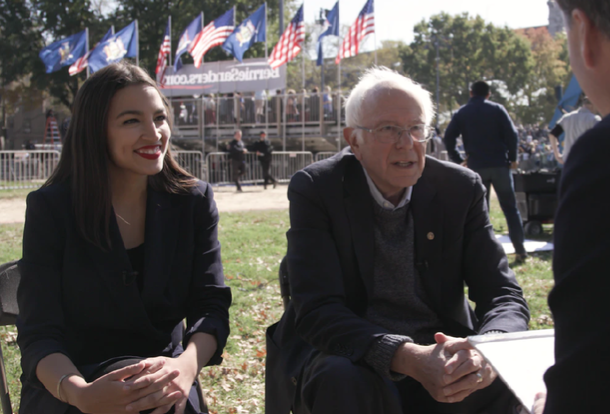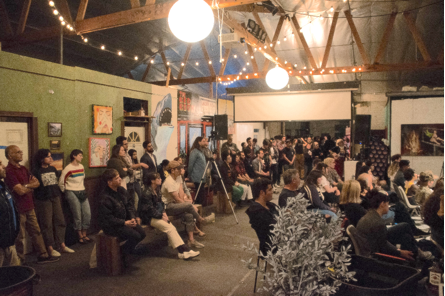CommentsPLANNING WATCH-Last week I was a panelist at a Bernie Sanders campaign event entitled “A Path to Housing Justice,” uploaded to YouTube. As you can see from the above picture, a packed house closely followed the discussion of the housing crisis.
As a campaign event, the tactics were spot on, but the jury is still out regarding the Senator’s long-term strategy. This event’s success was based on inviting supporters to a renters-rights panel, silent art auction, open bar and taco stand, standup comedians, DJ, and band. It was a magnet for the woke, and I am sure those who attended left as dedicated Sanders voters and helped him win the California primary. If Sanders manages to overcome the Democratic Party’s old guard and become its 2020 presidential candidate, these Berniecrats, whether new or old, will actively support him, many as volunteers.
Brilliant campaign tactics: The following reflected the short-term tactical skills to plan this campaign event:
- Bernie staffers and volunteers organized this event through social media.
- The event was publicized as a Sanders fundraiser, but the panel never mentioned the candidate, his housing proposals, or how they compared to other candidates’ programs.
- If you wanted, however, to understand why your rent was so high and what legislative remedies were in the works, you would have been delighted.
- The panel continuously evolved and eventually became a platform for advocates of state and city legislation to strengthen tenants rights and rent control, especially through the California Rental Affordability Act (RAA), a November ballot initiative.
- The panel was tightly run. The format consisted of written questions that the moderators directed to specific panelists, without any follow-up Q and A. The moderators were discreetly guided by a professional campaign operative who sat in the front row, flashing them hand signals.
- For those who wanted further information on renters’ rights, proposed legislation, voting, and the Sanders campaign, busy tables were unobtrusively located near the bar, taco stand, and dance floor.
I have little doubt that events like this played a key role in Sanders’ success in Tuesday’s California primary victory. Yes, the Senator has taken strong positions on economic inequality, health care, education, climate, and housing, but based on this event, the campaign’s approach to California turned on meticulous logistics, not public policy.
What about the looming strategic challenges once the November 2020 election is over? If Bernie Sanders overcomes Democratic Party insider Joe Biden to become the Democratic Party’s presidential candidate and then beats Donald Trump, he will face three enormous strategic challenges that were ignored at this campaign event.
The first challenge to a Sanders administration would be submitting its legislative package to a hostile Congress. Many commentators predict Republicans and corporate Democrats would quickly bury these proposals. Senator Sanders has clearly acknowledged this reality and made it clear he is organizing a political movement, not just a campaign. While this sounds great, last week’s campaign event made no mention of a permanent grassroots movement to salvage a Sanders presidential administration from a hostile Congress.

Bernie and AOC told the Intercept: “We need an ongoing grassroots movement of millions of people to pressure Congress, to pressure the corporate establishment, so that we can bring about the changes that this country desperately needs. That’s why I have said that I will not only be commander-in-chief, I’m going to be organizer-in-chief.”
The second issue is the strategic difference between an election campaign and a political movement. It is hard to get activists involved in mass movements to leave the streets and turn to the ballot box on election day. It is even harder to persuade those who have been skillfully drawn into electoral politics to suddenly switch gears and a mass movement.
For example, George W. Bush‘s invasions of Afghanistan and Iraq sparked a global anti-war movement, and candidate Barack Obama skillfully wooed the American portion of this anti-war movement to vote for him as a peace candidate. Then, when President Obama turned out to be a hawk, escalating in Afghanistan and ordering drone missile attacks on seven countries – including extra-judicial assassinations of U.S. citizens -- the jilted anti-war movement faded away. Furthermore, the Obama Administration’s coordination with local police departments, like the LAPD, to violently crush the Occupy movement reinforced the rift between the Democratic Party establishment and political activists.
The third issue is related to the second issue. Both U.S. political parties are fully committed to an interventionist, highly militarized, bi-partisan U.S. foreign policy. This reality has been barely been raised during the current presidential campaign, but it will be front and center come January 2021. Why? Because, unlike Joe Biden, Senator Sanders has made it clear that cuts in military spending will partially fund his ambitious health, education, housing, and climate programs. Once this struggle begins, without support from a massive grass roots movement that opposes U.S. militarism, Congress and the media would neuter a Sanders administration.
Since the Feb. 27 campaign event never mentioned the need for a powerful non-electoral, post-election movement, the jury is out whether a future Sanders administration could suddenly switch gears. Will it be able to move its base from electoral politics (back) to a mass, grass roots movement to fight for its legislative agenda?
If the Sanders team hopes to succeed with its legislative package, such as a Congressional reauthorization of terminated HUD public housing programs, the time to act is now, not in early 2021, when most Sanders supporters will return to their pre-campaign lives.
(Dick Platkin is a former Los Angeles city planner who reports on local planning issues for CityWatch. He serves on the board of United Neighborhoods for Los Angeles (UN4LA) and is co-chair of the new Greater Fairfax Residents Association. Please send comments and corrections to [email protected].) Prepped for CityWatch by Linda Abrams.














